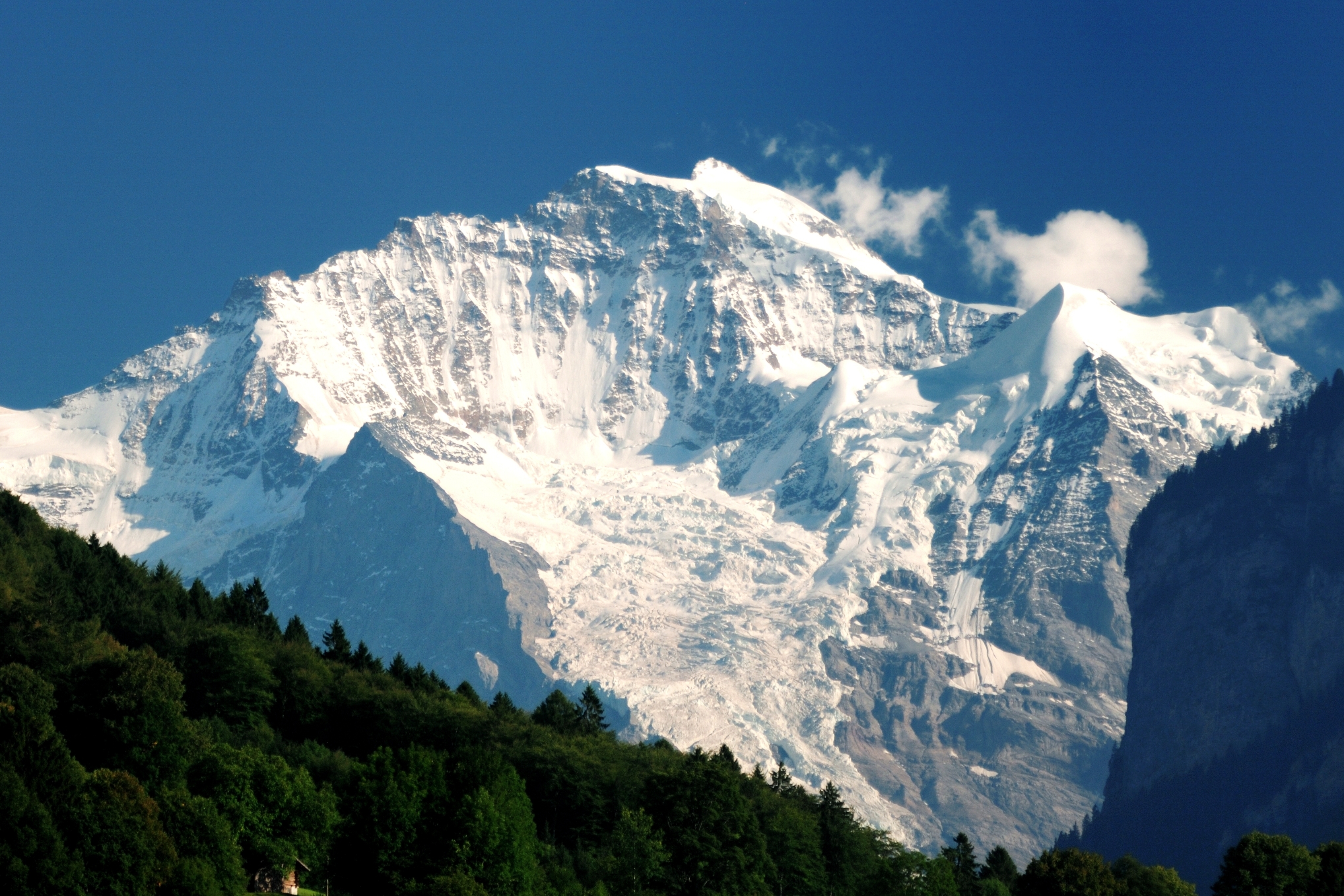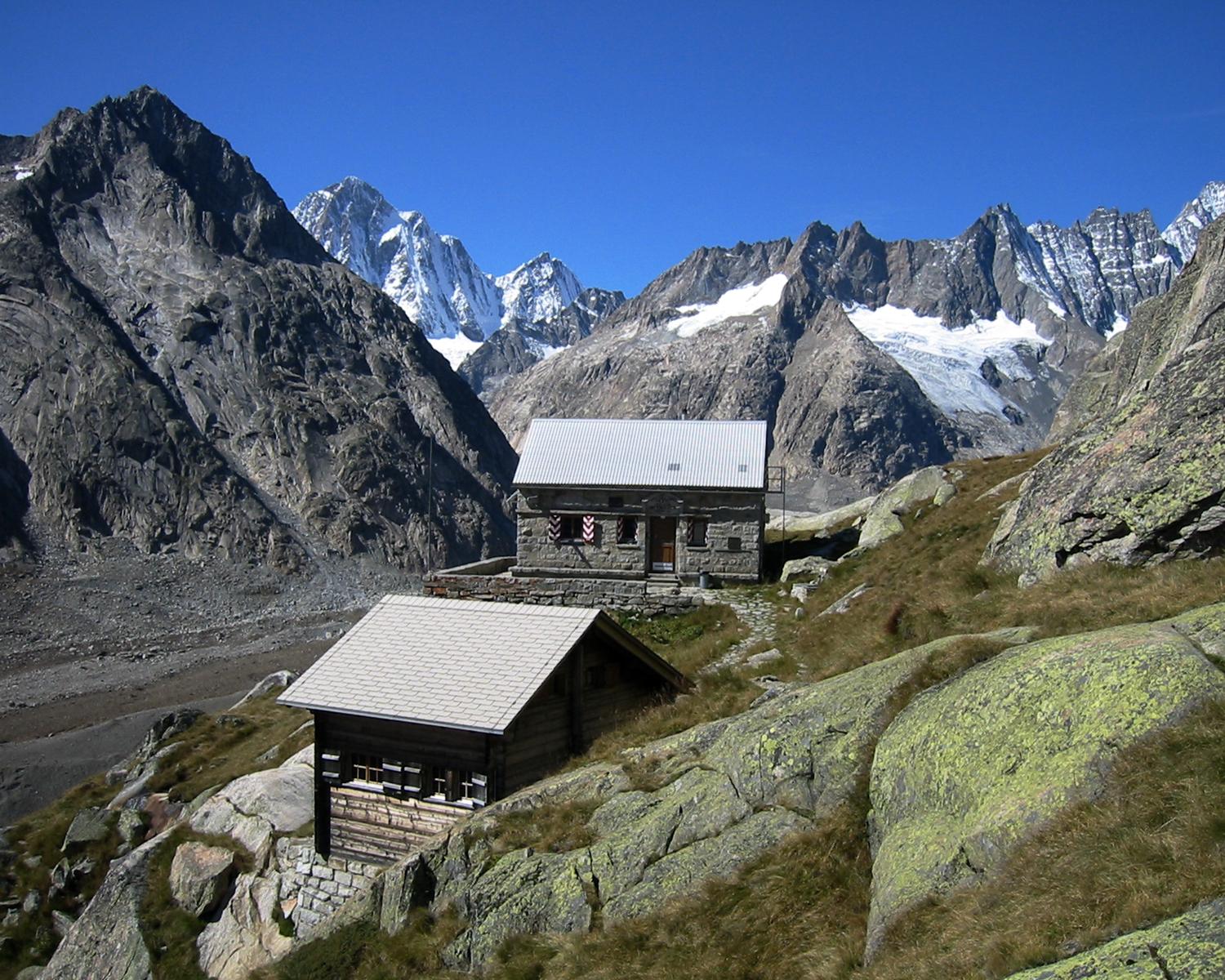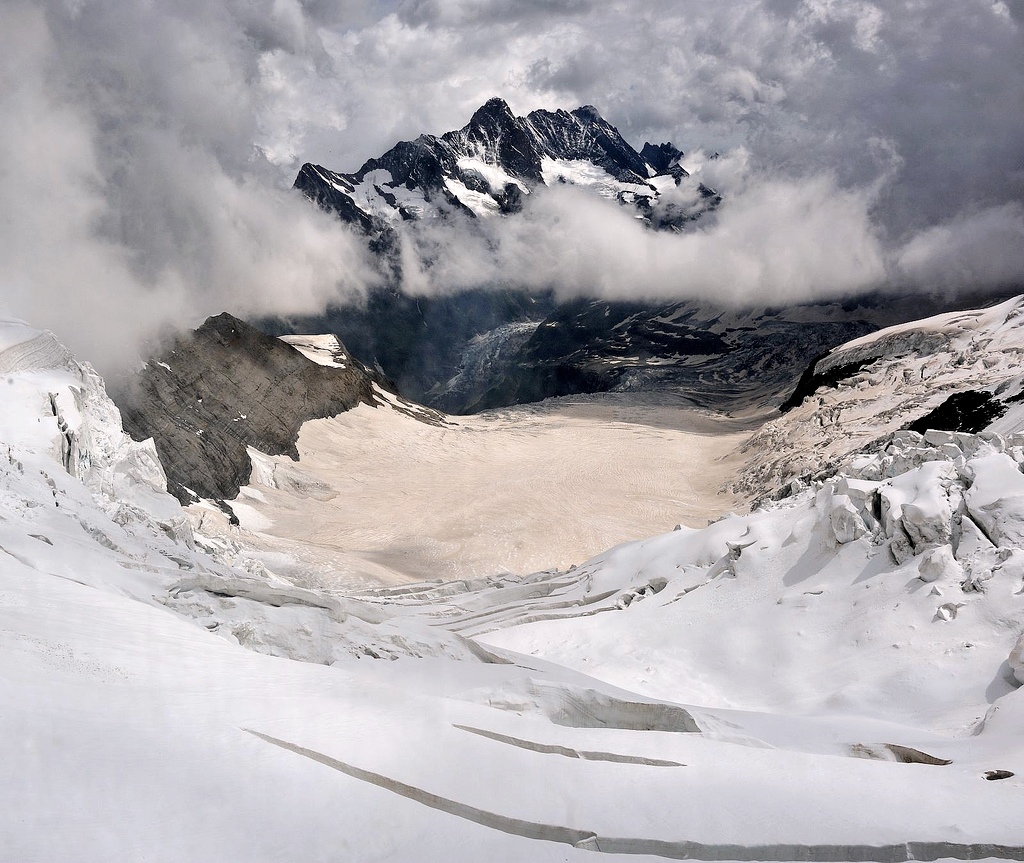|
Finsteraarhorn
The Finsteraarhorn () is a mountain lying on the border between the cantons of Bern and Valais. It is the highest mountain of the Bernese Alps and the most prominent peak of Switzerland. The Finsteraarhorn is the ninth-highest mountain and third-most prominent peak in the Alps. In 2001 the whole massif and surrounding glaciers were designated as part of the Jungfrau-Aletsch World Heritage Site. Geography Despite being the most elevated, prominent and isolated mountain of both the Bernese Alps and the canton of Berne, the Finsteraarhorn is less known and frequented than the nearby Jungfrau and Eiger. This is due to its location in one of the most remote areas in the Alps, completely surrounded by un-inhabited glacial valleys. To its west lies the Fiescher Glacier, the second longest in the Alps, and to the east lie the Great Aar Glaciers. The smaller Lower Grindelwald Glacier lies north of the massif. The Finsteraarhorn is surrounded by the summits of the Schreckhorn and ... [...More Info...] [...Related Items...] OR: [Wikipedia] [Google] [Baidu] |
List Of Alpine Peaks By Prominence
This is a list of the mountains of the Alps, ordered by their topographic prominence. For a list by height, see the list of mountains of the Alps. By descending to 1,500 m of prominence, this list includes all the Ultras of the Alps. Some famous peaks, such as the Matterhorn and Eiger, are not Ultras because they are connected to higher mountains by high cols and therefore do not achieve enough topographic prominence. Where the '' prominence parent'' and the '' island parent'' differ, the prominence parent is marked with "1" and the island parent with "2" (with Mont Blanc abbreviated to ''MB''). The column "Col height" denotes the lowest elevation to which one must descend from a peak in order to reach peaks with higher elevations; note that the elevation of any peak is the sum of its prominence and col. The column "Col location" denotes the pass where the col height is located. See also * Worldwide list of peaks ranked by prominence *List of mountains of Switzerland (with he ... [...More Info...] [...Related Items...] OR: [Wikipedia] [Google] [Baidu] |
Jungfrau
The Jungfrau ( "maiden, virgin"), at is one of the main summits of the Bernese Alps, located between the northern canton of Bern and the southern canton of Valais, halfway between Interlaken and Fiesch. Together with the Eiger and Mönch, the Jungfrau forms a massive wall of mountains overlooking the Bernese Oberland and the Swiss Plateau, one of the most distinctive sights of the Swiss Alps. The summit was first reached on August 3, 1811, by the Meyer brothers of Aarau and two chamois hunters from Valais. The ascent followed a long expedition over the glaciers and high passes of the Bernese Alps. It was not until 1865 that a more direct route on the northern side was opened. The construction of the Jungfrau Railway in the early 20th century, which connects Kleine Scheidegg to the Jungfraujoch, the saddle between the Mönch and the Jungfrau, made the area one of the most-visited places in the Alps. Along with the Aletsch Glacier to the south, the Jungfrau is part of the Jung ... [...More Info...] [...Related Items...] OR: [Wikipedia] [Google] [Baidu] |
Bernese Alps
, topo_map= Swiss Federal Office of Topography swisstopo , photo=BerneseAlps.jpg , photo_caption=The Eiger, Mönch, and Jungfrau , country= Switzerland , subdivision1_type= Cantons , subdivision1= , parent= Western Alps , borders_on= , length_mi= , length_orientation= , width_mi= , width_orientation= , geology= , orogeny= , highest= Finsteraarhorn , elevation_m=4274 , range_coordinates= , coordinates= , map_image=Berner Alpen.png , map_caption=Map of Bernese Alps and their location in Switzerland (red) The Bernese Alps (german: Berner Alpen, french: Alpes bernoises, it, Alpi bernesi) are a mountain range of the Alps, located in western Switzerland. Although the name suggests that they are located in the Berner Oberland region of the canton of Bern, portions of the Bernese Alps are in the adjacent cantons of Valais, Fribourg and Vaud, the latter being usually named ''Fribourg Alps'' and ''Vaud Alps'' respectively. The highest mountain in the range, the ... [...More Info...] [...Related Items...] OR: [Wikipedia] [Google] [Baidu] |
Gross Fiescherhorn
Grosses Fiescherhorn is a mountain peak of the Bernese Alps, located on the border between the cantons of Bern and ValaisValais, halfway between the Mönch and the Finsteraarhorn. At above sea level, its summit culminates over the whole Fiescherhorn massif (german: Fiescherhörner), which is also composed of the slightly lower Hinteres Fiescherhorn () to the south and Kleines Fiescherhorn (also called ''Ochs'' aka ox, ) to the east. From the north both are well hidden behind other mountain peaks and can only been seen from ''Isch'' in Grindelwald (1,095 m). The mountain is shared between the municipalities of Grindelwald and Fieschertal. Ascents are usually made from one of these three popular routes: one starts from the Mönchsjoch Hut, one from the Konkordia Hut, and the third from the Finsteraarhorn Hut. Climbing history The summit was first reached on 23 July 1862 by H. B. George and Adolphus Warburton Moore, with guides Christian Almer and Ulrich Kaufmann. They us ... [...More Info...] [...Related Items...] OR: [Wikipedia] [Google] [Baidu] |
Jungfrau-Aletsch Protected Area
The Jungfrau-Aletsch protected area (officially Swiss Alps Jungfrau-Aletsch) is located in south-western Switzerland between the cantons of Berne and Valais. It is a mountainous region in the easternmost side of the Bernese Alps, containing the northern wall of Jungfrau and Eiger, and the largest glaciated area in western Eurasia, comprising the Aletsch Glacier. The Jungfrau-Aletsch protected area is the first World Natural Heritage site in the Alps; it was inscribed in 2001. . Retrieved on 2009-10-18 Geography and climate The Jungfrau-Aletsch protected area is located in the[...More Info...] [...Related Items...] OR: [Wikipedia] [Google] [Baidu] |
Fiescher Glacier
The Fiescher Glacier (''Fieschergletscher'' in German) is a valley glacier on the south side of the Bernese Alps in the canton of Valais, Switzerland. in length, it is the second longest glacier in the Alps. The glacier covers an area of . The starting point of the Fiescher Glacier is above sea level, on the eastern slope of the Fiescherhorn, it is flanked to the west by the Grünhorn and Gross Wannenhorn and to the east by the Finsteraarhorn. In the lower section, the Fiescher Glacier flows south through a deep valley between the Gross Wannenhorn and the Wasenhorn. In summer, when the snow layer melts, it has a grey colour as it is covered with rocks coming from the steep slopes of the mountains around. The end of glacier tongue is at around above sea level. On the south western slope of the Finsteraarhorn, about above the Fieschergletscher, the Finsteraarhornhütte of the Swiss Alpine Club ( above sea level) is often used as an intermediate station on the route from Lö ... [...More Info...] [...Related Items...] OR: [Wikipedia] [Google] [Baidu] |
Schreckhorn Finsteraarhorn
The Schreckhorn (4,078 m) is a mountain in the Bernese Alps. It is the highest peak located entirely in the canton of Berne. The Schreckhorn is the northernmost Alpine four-thousander and the northernmost summit rising above 4,000 metres in Europe. Geography The Schreckhorn is located 10 km south-east of Grindelwald between the Upper and Lower Grindelwald Glacier. The region is made up of uninhabited glacial valleys, the great Aar Glaciers and the Fiescher Glacier. The summit of the Lauteraarhorn is located very close and reaches almost the same altitude. The highest peak of the Bernese Alps, the Finsteraarhorn lies 6 km to the south. Geologically the Schreckhorn is part of the Aarmassif. Climbing history The first ascent was on 16 August 1861 by Leslie Stephen, Ulrich Kaufmann, Christian Michel and Peter Michel. Their route of ascent, via the upper Schreck Couloir to the Schrecksattel and then by the south-east ridge, was the normal route for the following ... [...More Info...] [...Related Items...] OR: [Wikipedia] [Google] [Baidu] |
Schreckhorn
The Schreckhorn (4,078 m) is a mountain in the Bernese Alps. It is the highest peak located entirely in the canton of Berne. The Schreckhorn is the northernmost Alpine four-thousander and the northernmost summit rising above 4,000 metres in Europe. Geography The Schreckhorn is located 10 km south-east of Grindelwald between the Upper and Lower Grindelwald Glacier. The region is made up of uninhabited glacial valleys, the great Aar Glaciers and the Fiescher Glacier. The summit of the Lauteraarhorn is located very close and reaches almost the same altitude. The highest peak of the Bernese Alps, the Finsteraarhorn lies 6 km to the south. Geologically the Schreckhorn is part of the Aarmassif. Climbing history The first ascent was on 16 August 1861 by Leslie Stephen, Ulrich Kaufmann, Christian Michel and Peter Michel. Their route of ascent, via the upper Schreck Couloir to the Schrecksattel and then by the south-east ridge, was the normal route for the followin ... [...More Info...] [...Related Items...] OR: [Wikipedia] [Google] [Baidu] |
Canton Of Bern
The canton of Bern or Berne (german: Kanton Bern; rm, Chantun Berna; french: canton de Berne; it, Canton Berna) is one of the 26 cantons forming the Swiss Confederation. Its capital city, Bern, is also the ''de facto'' capital of Switzerland. The bear is the heraldic symbol of the canton, displayed on a red-yellow background. Comprising ten districts, Bern is the second-largest canton by both surface area and population. Located in west-central Switzerland, it is surrounded by eleven cantons. It borders the canton of Jura and the canton of Solothurn to the north. To the west lie the canton of Neuchâtel, the canton of Fribourg and canton of Vaud. To the south lies the canton of Valais. East of the canton of Bern lie the cantons of Uri, Nidwalden, Obwalden, Lucerne and Aargau. The geography of the canton includes a large share of all three natural regions of Switzerland: the Jura Mountains (the Bernese Jura), the Swiss Plateau (the Bernese Mittelland) and the Alps (th ... [...More Info...] [...Related Items...] OR: [Wikipedia] [Google] [Baidu] |
List Of Mountains Of The Alps
This page tabulates only the most prominent mountains of the Alps, selected for having a topographic prominence of ''at least'' , and all of them exceeding in height. Although the list contains 537 summits, some significant alpine mountains are necessarily excluded for failing to meet the stringent prominence criterion. The list of these most prominent mountains is continued down to 2500 m elevation at List of prominent mountains of the Alps (2500–2999 m) and down to 2000 m elevation on List of prominent mountains of the Alps (2000–2499 m). All such mountains are located in either France, Italy, Switzerland, Liechtenstein, Austria, Germany or Slovenia, even in some lower regions. Together, these three lists include all 44 ultra-prominent peaks of the Alps, with 19 ultras over 3000m on this page. For a definitive list of all 82 the highest peaks of the Alps, as identified by the International Climbing and Mountaineering Federation (UIAA), and often referred to as th ... [...More Info...] [...Related Items...] OR: [Wikipedia] [Google] [Baidu] |
List Of Prominent Mountains Of Switzerland
This article contains a sortable table of many of the major mountains and hills of Switzerland. The table only includes those summits that have a topographic prominence of at least above other points, and ranks them by height and prominence. Therefore it only includes mountains that might generally be regarded as 'independent' and covers most of the country, even lower areas. For a fuller list of mountains, including subsidiary points, see List of mountains of Switzerland above 3000 m and List of mountains of Switzerland above 3600 m. For a list of just the most isolated mountains, see List of most isolated mountains of Switzerland. Along with the lakes, mountains constitute a major natural feature of Switzerland with most of the cantons having summits exceeding and three of them having summits exceeding . The two main mountain ranges are the Alps (south and east) and the Jura (north and west), separated by the Swiss Plateau which also includes a large number of hills. To ... [...More Info...] [...Related Items...] OR: [Wikipedia] [Google] [Baidu] |
Valais
Valais ( , , ; frp, Valês; german: Wallis ), more formally the Canton of Valais,; german: Kanton Wallis; in other official Swiss languages outside Valais: it, (Canton) Vallese ; rm, (Chantun) Vallais. is one of the 26 cantons forming the Swiss Confederation. It is composed of thirteen districts and its capital and largest city is Sion. The flag of the canton is made of thirteen stars representing the districts, on a white-red background. Valais is situated in the southwestern part of the country. It borders the cantons of Vaud and Bern to the north, the cantons of Uri and Ticino to the east, as well as Italy to the south and France to the west. It is one of the three large southern Alpine cantons, along with Ticino and the Grisons, which encompass a vast diversity of ecosystems. It is a bilingual canton, French and German being its two official languages. Traditionally, the canton is divided into Lower, Central, and Upper Valais, the latter region constituting the Germa ... [...More Info...] [...Related Items...] OR: [Wikipedia] [Google] [Baidu] |








